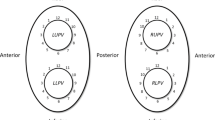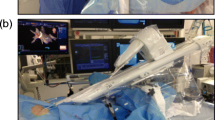Abstract
Background
Long-term results after circumferential pulmonary vein isolation (CPVI) for the treatment of paroxysmal atrial fibrillation (PAF) using a robotic navigation system (RNS) have not yet been reported.
Objective
To evaluate long-term results of patients with PAF after CPVI using RNS.
Methods
In this study, 200 patients (n = 151 (75.5 %) male; median age 62.2 (54.7–67.7) years) with PAF were evaluated. In 100 patients, RNS (RN-group) was used for CPVI and compared to 100 manually ablated control patients (MN-group). Radiofrequency was used in conjunction with 3D electroanatomic mapping. Power was limited to 30 watts (W) at the posterior left atrial (LA) wall in the first 49 RNS patients (RN-group-a). After esophageal perforation occurred in one RN-group-a patient, maximum power was reduced to 20 W for the subsequent 51 patients (RN-group-b).
Results
After a median follow-up of 2 years, single (77/100 vs 77/100, p = 0.89) and multiple (90/100 vs 93/100, p = 0.29) procedure success rates were comparable between RN-group and MN-group. Single procedure success rate was significantly lower in RN-group-a as compared to RN-group-b (65.3 vs 88.2 %, p = 0.047). In RN-group-a patients, procedural times [200 (170–230) vs 152 (132–200) minutes, p < 0.01] and fluoroscopy times [16.6 (12.9–21.6) minutes vs 13.7 (9.5–19) minutes, p = 0.043] were significantly longer compared to RN-group-b patients.
Conclusion
Long-term success rate after CPVI using RNS was comparable to manual ablation. Despite a lower power limit of 20 W at the posterior LA wall, single procedure success rate was higher in RN-group-b as compared to RN-group-a. Procedure time and fluoroscopy time decreased, whilst success rate increased with increasing experience in the RN-group.



Similar content being viewed by others
References
Schnabel RB, Wilde S, Wild PS, Munzel T, Blankenberg S (2012) Atrial fibrillation: its prevalence and risk factor profile in the German general population. Dtsch Arztebl Int 109(16):293–299
Ouyang F, Tilz R, Chun J, Schmidt B, Wissner E, Zerm T, Neven K, Köktürk B, Konstantinidou M, Metzner A, Fuernkranz A, Kuck KH (2010) Long-term results of catheter ablation in paroxysmal atrial fibrillation: lessons from a 5 year follow-up. Circulation 122:2368–2377
Medi C, Sparks PB, Morton JB, Kistler PM, Halloran K, Rosso R, Vohra JK, Kumar S, Kalman JM (2011) Pulmonary vein antral isolation for paroxysmal atrial fibrillation: results from long-term follow-up. J Cardiovasc Electrophysiol 22:137–141
Chun KR, Schmidt B, Kuck KH, Andresen D, Willems S, Spitzer SG, Hoffmann E, Schumacher B, Eckardt L, Seidl K, Jünger C, Horack M, Brachmann J, Senges J (2013) Catheter ablation of atrial fibrillation in the young: insights from the German Ablation Registry. Clin Res Cardiol 102(6):459–468
Tilz RR, Rillig A, Thum AM, Arya A, Wohlmuth P, Metzner A, Mathew S, Yoshiga Y, Wissner E, Kuck KH, Ouyang F (2012) Catheter ablation of long-standing persistent atrial fibrillation: 5-year outcomes of the Hamburg Sequential Ablation Strategy. J Am Coll Cardiol 60(19):1921–1929
Rillig A, Lin T, Burchard A, Kamioka M, Heeger C, Makimoto H, Metzner A, Wissner E, Wohlmuth P, Ouyang F, Kuck KH, Tilz RR (2014) Modified energy settings are mandatory to minimize esophageal injury using the novel multipolar irrigated radiofrequency ablation catheter for pulmonary vein isolation. Europace. pii: euu269. (Epub ahead of print)
Saliba W, Reddy VY, Wazni O, Cummings JE, Burkhardt JD, Haissaguerre M, Kautzner J, Peichl P, Neuzil P, Schibgilla V, Noelker G, Brachmann J, Di Biase L, Barrett C, Jais P, Natale A (2008) Atrial fibrillation ablation using a robotic catheter remote control system: initial human experience and long-term follow-up results. J Am Coll Cardiol 51:2407–2411
Schmidt M, Dorwarth U, Straube F, Wankerl M, Krieg J, Leber AW, Ebersberger HU, Daccarett M, Huber A, Rummeny E, Hoffmann E (2012) A novel double cryoballoon strategy in persistent atrial fibrillation: a pilot study. Clin Res Cardiol 101(10):777–785
Buiatti A, Hessling G, Semmler V, Ammar S (2014) Remote magnetic navigation for persistent atrial fibrillation ablation via a retrograde aortic access: an approach for patients after atrial septal defect device closure. Clin Res Cardiol 103(12):1028–1030
Schmidt B, Tilz RR, Neven K, Julian Chun KR, Fürnkranz A, Ouyang F (2009) Remote robotic navigation and electroanatomical mapping for ablation of atrial fibrillation: considerations for navigation and impact on procedural outcome. Circ Arrhythm Electrophysiol 2:120–128
Hlivák P, Mlčochová H, Peichl P, Cihák R, Wichterle D, Kautzner J (2011) Robotic navigation in catheter ablation for paroxysmal atrial fibrillation: midterm efficacy and predictors of postablation arrhythmia recurrences. J Cardiovasc Electrophysiol 22(5):534–540
Di Biase L, Wang Y, Horton R, Gallinghouse GJ, Mohanty P, Sanchez J, Patel D, Dare M, Canby R, Price LD, Zagrodzky JD, Bailey S, Burkhardt JD, Natale A (2009) Ablation of atrial fibrillation utilizing robotic catheter navigation in comparison to manual navigation and ablation: single-center experience. J Cardiovasc Electrophysiol 20:1328–1335
Rillig A, Meyerfeldt U, Birkemeyer R, Treusch F, Kunze M, Miljak T, Zvereva V, Jung W (2010) Remote robotic catheter ablation for atrial fibrillation: how fast is it learned and what benefits can be earned? J Inter Cardiac Electrophysiol 29:109–117
Willems S, Steven D, Servatius H, Hoffmann BA, Drewitz I, Müllerleile K, Aydin MA, Wegscheider K, Salukhe TV, Meinertz T, Rostock T (2010) Persistence of Pulmonary Vein Isolation After Robotic Remote-Navigated Ablation for Atrial Fibrillation and its Relation to Clinical Outcome. J Cardiovasc Electrophysiol 21:1079–1084
Ullah W, McLean A, Hunter RJ, Baker V, Richmond L, Cantor EJ, Dhinoja MB, Sporton S, Earley MJ, Schilling RJ (2014) Randomized trial comparing robotic to manual ablation for atrial fibrillation. Heart Rhythm 11(11):1862–1869
Tilz RR, Chun KR, Metzner A, Burchard A, Wissner E, Koektuerk B, Konstantinidou M, Nuyens D, De Potter T, Neven K, Fürnkranz A, Ouyang F, Schmidt B (2010) Unexpected high incidence of esophageal injury following pulmonary vein isolation using robotic navigation. J Cardiovasc Electrophysiol 21:853–858
Camm AJ, Lip GY, De Caterina R, Savelieva I, Atar D, Hohnloser SH, Hindricks G, Kirchhof P (2012) ESC Committee for Practice Guidelines-CPG; Document Reviewers: 2012 focused update of the ESC Guidelines for the management of atrial fibrillation: an update of the 2010 ESC Guidelines for the management of atrial fibrillation—developed with the special contribution of the European Heart Rhythm Association. Europace 14(10):1385–1413
Rillig A, Meyerfeldt U, Birkemeyer R, Wiest S, Sauer BM, Staritz M, Jung W (2010) Oesophageal temperature monitoring and incidence of oesophageal lesions after pulmonary vein isolation using a remote robotic navigation system. Europace 12:655–661
Rillig A, Meyerfeldt U, Tilz RR, Talazko J, Arya A, Zvereva V, Birkemeyer R, Miljak T, Hajredini B, Wohlmuth P, Fink U, Jung W (2012) Incidence and long-term follow-up of silent cerebral lesions after pulmonary vein isolation using a remote robotic navigation system as compared with manual ablation. Circ Arrhythm Electrophysiol 5(1):15–21
Rillig A, Meyerfeldt U, Kunze M, Birkemeyer R, Miljak T, Jäckle S, Hajredini B, Treusch F, Jung W (2010) Persistent iatrogenic atrial septal defect after a single-puncture, double-transseptal approach for pulmonary vein isolation using a remote robotic navigation system: results from a prospective study. Europace 12:331–336
Rillig A, Schmidt B, Feige B, Wissner E, Metzner A, Arya A, Mathew S, Makimoto H, Wohlmuth P, Ouyang F, Kuck KH (2013) Tilz RR (2013) Left atrial isthmus line ablation using a remote robotic navigation system: feasibility, efficacy and long-term outcome. Clin Res Cardiol 102(12):885–893
Bai R, Biase DI, Valderrabano M, Lorgat F, Mlcochova H, Tilz R, V U, Hranitzky PM, Wazni O, Kanagaratnam P, Doshi RN, Gibson D, Pisapia A, Mohanty P, Saliba W, Ouyang F, Kautzner J, Gallinghouse GJ, Natale V (2012) Worldwide experience with the robotic navigation system in catheter ablation of atrial fibrillation: methodology, efficacy and safety. J Cardiovasc Electrophysiol 23(8):820–826
Di Biase L, Natale A, Barrett C, Tan C, Elayi CS, Ching CK, Wang P, Al-Ahmad A, Arruda M, Burkhardt JD, Wisnoskey BJ, Chowdhury P, De Marco S, Armaganijan L, Litwak KN, Schweikert RA, Cummings JE (2009) Relationship between catheter forces, lesion characteristics, “popping”, and char formation: experience with robotic navigation system. J Cardiovasc Electrophysiol 20:436–440
Wakili R, Clauss S, Schmidt V, Ulbrich M, Hahnefeld A, Schüssler F, Siebermair J, Kääb S, Estner HL (2014) Impact of real-time contact force and impedance measurement in pulmonary vein isolation procedures for treatment of atrial fibrillation. Clin Res Cardiol 103(2):97–106
Steven D, Servatius H, Rostock T, Hoffmann B, Drewitz I, Müllerleile K, Sultan A, Aydin MA, Meinertz T, Willems S (2010) Reduced fluoroscopy during atrial fibrillation ablation: benefits of robotic guided navigation. J Cardiovasc Electrophysiol 21:6–12
Rillig A, Schmidt B, Steven D, Meyerfeldt U, Biase DI, Wissner E, Becker R, Thomas D, Wohlmuth P, Gallinghouse GJ, Scholz E, Jung W, Willems S, Natale A, Ouyang F, Kuck KH, Tilz R (2013) Study design of the man and machine trial: a prospective international controlled noninferiority trial comparing manual with robotic catheter ablation for treatment of atrial fibrillation. J Cardiovasc Electrophysiol 24(1):40–46
Kiliszek M, Miązek N, Peller M, Gajda S, Koźluk E, Lodziński P, Kapłon-Cieślicka A, Piątkowski R, Budaj-Fidecka A, Balsam P, Opolski G (2014) Influence of left atrial size on the outcome of pulmonary vein isolation in patients with atrial fibrillation. Kardiol Pol 72(11):1135–1140
Özcan EE, Szeplaki G, Tahin T, Osztheimer I, Szilagyi S, Apor A, Horvath PM, Vago H, Merkely B, Geller L (2014) Impact of respiration gating on image integration guided atrial fibrillation ablation. Clin Res Cardiol 103(9):727–731
Hahnefeld A, Reithmann C, Ulbrich M, Haserück N, Siebermair J, Steinbeck G (2009) CARTO versus NavX bei der Ablation von paroxysmalem Vorhofflimmern. (CAVERNA AF Studie): vergleich bei 222 konsekutiven Patienten. Clin Res Cardiol 98(1):V270
Author information
Authors and Affiliations
Corresponding author
Ethics declarations
Conflict of interest
Andreas Rillig received travel grants from Biosense Webster, Hansen Medical and St. Jude Medical and lecture fees from St. Jude Medical and takes part at the Boston scientific EP fellowship; Tina Lin received a fellowship grant from EHRA and travel grants from Biosense Webster, St. Jude Medical and Topera Medical. Roland Tilz received research grants from Hansen, St. Jude Medical, travel grants from St. Jude Medical, Topera, Biosense Webster, Daiichi Sankyo, Sentrheart and speaker‘s bureau honoraria from Biosense Webster, Biotronik, Pfizer, Topera, Bristol-Myers Squibb; Bayer, Sanofi Aventis. Prof. Kuck has received research grants from Biosense Webster, Stereotaxis, Prorhythm, Medtronic, Edwards, and Cryocath; and is a consultant to St. Jude Medical, Biosense Webster, Prorhythm, and Stereotaxis.
Rights and permissions
About this article
Cite this article
Rillig, A., Lin, T., Schmidt, B. et al. Experience matters: long-term results of pulmonary vein isolation using a robotic navigation system for the treatment of paroxysmal atrial fibrillation. Clin Res Cardiol 105, 106–116 (2016). https://doi.org/10.1007/s00392-015-0892-6
Received:
Accepted:
Published:
Issue Date:
DOI: https://doi.org/10.1007/s00392-015-0892-6




